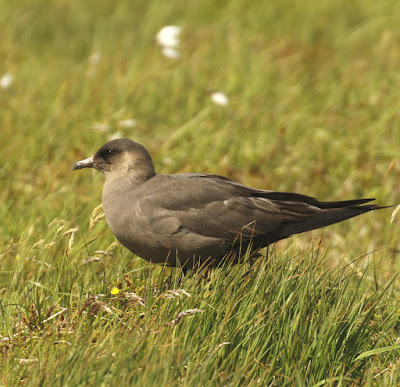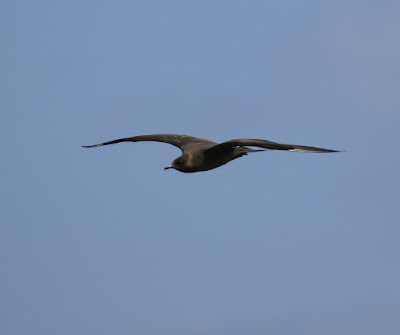Two years ago in June I made my one and only visit to Handa Island which lies off the coast of Sutherland in northwest Scotland. This June a family holiday at Achiltibuie, an hour's drive south of Handa gave me the opportunity to take the family there and, of course, for me to make a welcome return visit to sample once again the delights of thousands of breeding seabirds but most of all the breeding Arctic and Great Skuas.
As before, the weather was kind and apart from a brief shower on the fifteen minute crossing from the tiny mainland hamlet of Tarbet to Handa the sun shone constantly, the sky remained forever blue and the awe inspiring background of distant mountains created their usual magnificent spectacle and imparted their own special magic to the day.
 |
| The Cliffs at Handa Island |
 |
| The Nature Table in the Bothy |
Wonderful as this was my focus was on the skuas and Arctic Skuas in particular. I have seen literally thousands of them passing various coasts of Britain as they make their migrations north or south across the sea but here on Handa I had the welcome and almost novel opportunity to see them on land and not just as moving shapes across a wide ocean. Arctic Skuas come in both a light morph and dark morph plumage and both were visible here. About the size of a Common Gull but with longer, more slender wings and pointed central tail feathers they are made for fast acrobatic flight and are supreme in the air, capable of the most amazing flying skills as they chase mainly terns and Kittiwakes to force them to disgorge fish from their crops.They are pirates in the true tradition, rakish, almost dandyish with their dark caps and plumage and with an indefinable charismatic even romantic presence.
Once they have finished breeding they migrate southwards across the seas and oceans to spend their winter far out to sea off the coasts of western and southern Africa. To watch them flying effortlessly on those long wings is to admire supreme elegance and grace.
Walking up the boardwalk we came to a pair of pale morph Arctic Skuas with a territory close to where we were standing. The birds rose from the moor grass, with yelping calls not dissimilar to a gull and soon were diving at us in an effort to dissuade us from coming any closer.They would sweep around over the moorland in a wide arc and rising up in the air before us would come in at speed on a steep dive only to rise at the last possible moment above our heads thus averting a collision, before repeating the manouevre again and again until satisfied we were no longer a threat, perceived or otherwise.
 |
| Great Skuas |
 |
| The Great Stack of Handa |
Great Skuas prospected the cliff face looking for unwary Kittiwake chicks or an unguarded auk's egg but they were confronted by such numbers of birds that they appeared confused and would drop away downwards on their huge, dark brown wings to glide menacingly across the sea. A Great Black backed Gull sat with bill tucked into its black feathers, apparently sleeping in the grass on the cliff top but its eyes were constantly roving, looking for the slightest sign of weakness in the wary Puffins ranged along the cliff edge near it. It would easily swallow one whole given the chance.
We sat here for an hour or so on the springy green turf just enjoying the ceaseless, ever changing spectacle of activity but I became restless. I wanted to get some photos of dark morph Arctic Skuas and had noticed that a pair had settled near to the boardwalk we had walked up earlier.
I wandered a few hundred metres back and found the pair of skuas alternately standing or sitting in the grass, a picture of contentment, but the minute another skua came near they would be on the alert and opening their bills wide would yelp in protest or warning and seemed especially annoyed or troubled by the Great Skuas. The dark morph Arctic Skuas look even more piratical than the light morph individuals and although not possessing the variety of colour tones are to my mind exceedingly smart in their dark chocolate plumage usually with a slightly paler buff patch on their cheeks and sides of the neck.
The warden told us there were thirty pairs of Arctic Skuas breeding on the island this year but in the last few years their success rate has been very low and no one currently can work out why. The majority of Arctic Skuas on the island are of the dark morph variety which makes sense as the lighter morph birds are to be increasingly found further north, beyond Scotland in Scandinavia and Arctic Russia, whilst the darker morph birds tend to be found in the more southerly parts of their range. such as Scotland
Three hours had passed in seemingly no time at all and soon it was time to go back to the beach to meet the boat that would take us back to the mainland and a late lunch in the tiny Shorehouse Restaurant overlooking the slipway, famed for its seafood and probably with one of the best sea views anywhere in Britain.












































No comments:
Post a Comment